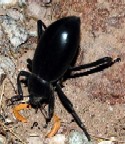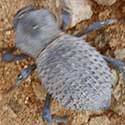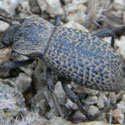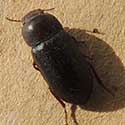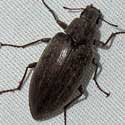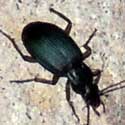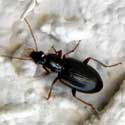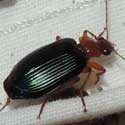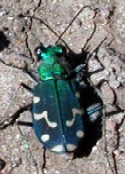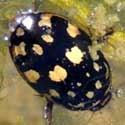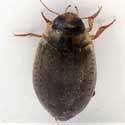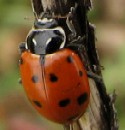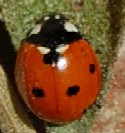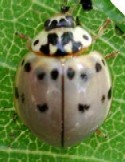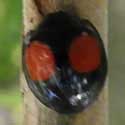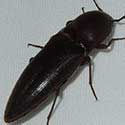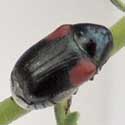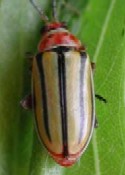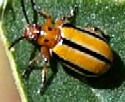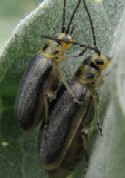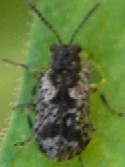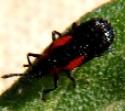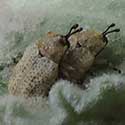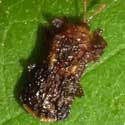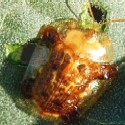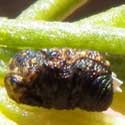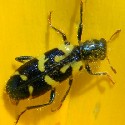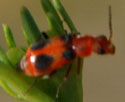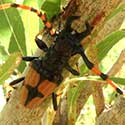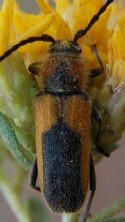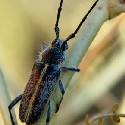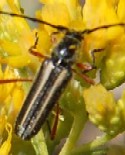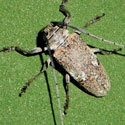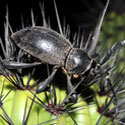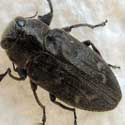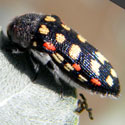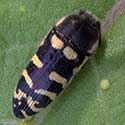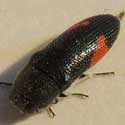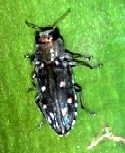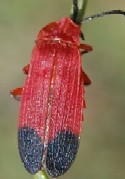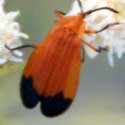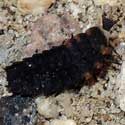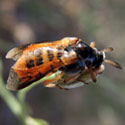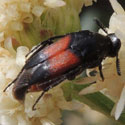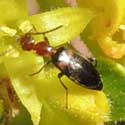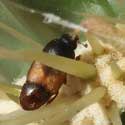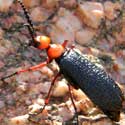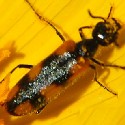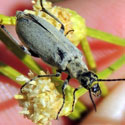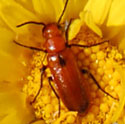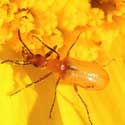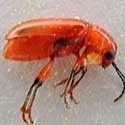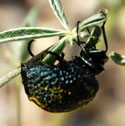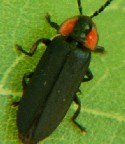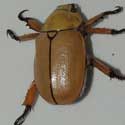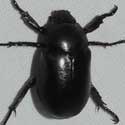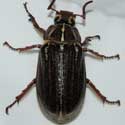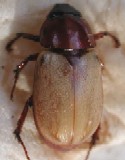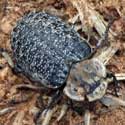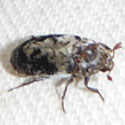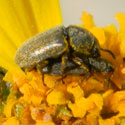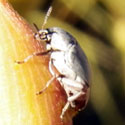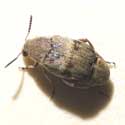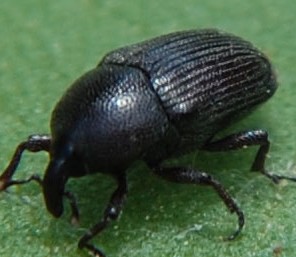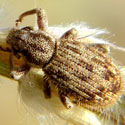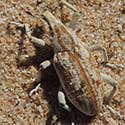Pinacate Beetle
Eleodes ca. spinipes
Large and jet-black. Sticks rear end up when disturbed. Forages by walking on ground. More info
Desert Ironclad Beetle
Asbolus verrucosus
One of two very similar tank-like beetles that can be found lumbering along on the desert. More info
Desert Ironclad Beetle
Cryptoglossa variolosa
Large, black, heavily armoured. Bumpy surface. Lumbers along soil. More info
Dead Wood Darkling
Armalia sp.
The many species of darkling beetles each have a different life history. This one came out of a dead tree branch. More info
Teneb Beetle
Epitragini
Dark gray-brown beetle that emerges at night to forage for an omnivorous diet. Many similar species. More info
Predaceous Ground Beetle
This fast-running beetle is a nocturnal hunter. Black with blue or green iridescence. More info
Small Ground Beetle
Harpalini
Shiny black beetle living on or near mostly damp soil. Elytra with distinct striations. More info
Foliage Ground Beetle
Lebia sp.
Smaller carabids that usually hunt on foliage and mostly at night. Elytra with green sheen and deep striations. Predatory. More info
Tiger Beetle
Cicindela oregona
Active and agile predators; large eyes and long legs. Flies about and lands/runs near damp sandy soil. Bright metalic blues, greens or browns. Several species. More info
Sunburst Diving Beetle
Thermonectus marmoratus
Glossy black with spots of golden yellow. Inhabits shallow pools in the depths of riparian canyons. More info
Predaceous Diving Beetle
Rhantus
Streamlined like a torpedo, equipped with paddle legs, and a pair of fold-up wings. More info
Convergent Lady Bird
Hippodamia convergens
Tomato-red with ca. 12 black spots. Pronotum shiny black with two converging white lines. Predatory on aphids and found on wide variety of plants. More info
Seven-spot Ladybird
Coccinella septempunctata
Tomato-red with seven black spots. Pronotum shiny black with two, lateral white spots. Predatory on aphids and found on wide variety of plants. Introduced. More info
Ashy Gray Lady Bird
Olla v-nigrum
Distinct pattern on dorsum of head and pronotum. Feeds on aphids particularily on trees in the spring. Can also be black with two orange spots! More info
Cactus Lady Beetle
Chilocorus cacti
Two red spots on glossy black elytra. Often found on prickly pear cactus, but also other plants with prey bugs. More info
Click Beetle
Elater sp.
Many species with distinctive shape and habit of snapping into a summersault to right themselves when placed on their back. More info
Red-shouldered Leaf Beetle
Saxinis
Elytra are shiny black and the belly had a coat of short white hairs. Found on leaves of palo verde. Several species. More info
Creosote Litter Leaf Beetle
Pachybrachus mellitus
Golden yellow brown. Small beetles less than 5mm. Found on leaves of Larrea. More info
Casebearer Leaf Beetle
Cryptocephalus atrofasciatus
Small, often colorful and intricately patterned. Head nearly obscured from above by pronotum. Many kinds. Found on fresh leaves of buckwheats and other plants. More info
Mesquite Casebearer
Cryptocephalus maccus
Small, shiny and intricately marked beetle with head obscured from view above. Found on new leaves of Velvet Mesquite. More info
Striped Willow Flea Beetle
Disonycha alternata
Elytra with three dark stripes on an amber background. Pronotum red-orange. Can jump. Found on new foliage of willows in spring. More info
Three-lined Potato Beetle
Lema daturaphila
Yellow with three black stripes. Pronotum with two black spots. Found on plants in potato family, Solanaceae. More info
Brittlebush Leaf Beetle
Trirhabda geminata
Light gray with pale yellow bordering. Feeds exclussively(?) on leaves of Brittlebush. More info
Mining Leaf Beetle
Monoxia sp.
Very small beetle that is usually associated with thick-leaved desert plants. Creates hollow blisters within the leaves. More info
Canyon Ragweed Leaf-miner
Microrhopala
Closely associated with Asteraceae plants. Flat, v. small, shiny beetles found on leaf surfaces. Larvae tunnel inside a leaf. More info
Mallow Leaf Miner
Stenopodius flavidus
This beetle pair is tucked into a fold of a desert mallow leaf. The larvae would be found tunneling with leaf tissue. More info
Leaf-Miner Beetle
Octotoma marginicollis
These small beetles chew on leaves of various plants as adults, but the flattened larvae tunnel into leaves. More info
Clavate Tortoise Beetle
Plagiometriona clavata
Closely associated with Datura plants. Mottled, golden brown and partly transparent shell that can hide body, head and legs. More info
Burroweed Leaf Beetle
Leptinotarsa lineolata
Pronotum is metalic green and elytra have dark stripes. Found on leaves of Hymenoclea. More info
Ambrosia Leaf Beetle
Zygogramma tortuosa
Light tan marked with burgandy brown. Found on leaves of Ambrosia. More info
Warty Leaf Beetle
Chlamisini
Resembles a fecal pellet of a caterpillar, and acts like one!. Several species on variety of desert plants, this one on Hymenoclea. More info
Ornate Checkered Beetle
Trichodes ornatus
Bright yellow and black markings on a small squared-off beetle. Notice clubbed antennae. Often in or on flowers feeding on pollen. More info
Soft-winged Flower Beetle
Attalus sp.
Small, mostly colorful beetles found on foliage and within flowers. Narrow pronotum between elytra and head. Many kinds. More info
Long-jawed Longhorn
Trachyderes mandibularis
Males only have the enlongated mandibles and very long antennae. Both sexes are orange with black cross marks. More info
Flower Longhorn
Crossidius sp.
Yellow-orange and black with long, stout antennae (horns). Found on flowers in late summer/fall. More info
Longhorn Beetle
Schizax senex
Dark burgandy to black with a paler yellow stripe along dorsum following wing edges. More info
Double-banded Bycid
Sphaenothecus bivittata
Dark brown with two light-colored bands. Long, stout antennae (horns). Found on flowers in late summer/fall. More info
Mesquite Girdler
Oncideres rhodisticta
Robust beetle with long antennae. Gray marked with dark gray and small, jewel-like spots. More info
Cactus Longhorn
Moneilema gigas
Lumbering, flightless beetles often found chewing on new cactus growth. Big antennae with a white ring on each. More info
Ocotillo Borer
Chrysobothris edwardsii
When an ocotillo dies or becomes weakened the larvae of these 5mm-long beetles might be among the insect recyclers. More info
Flower Buprestid
Acmaeodera gibbula
Black beetle with two rows of five yellow spots along center line and three red spots along each lateral edge. More info
Acmaeodera
Acmaeodera alicia
Bullet-shaped beetles usu. back and marked with bright colors. On flowers and foliage in spring and fall. More info
Flower Buprestid
Acmaeodera acanthicola
This colorful flower buprestid is much smaller than most species, about 3 mm. More info
Wood-boring Beetle
Hippomelas spenicus
One of largest buprestids in Sonoran Desert. Dark brown with coppery pubescence. Large-eyed and wary. More info
Round-headed Borer
Chrysobothris sp.
Mostly dark brown or black with coppery sheen. Shiny dots on elytra. Adults are attracted to dead or dying tree branches. Many similar species. More info
Net-winged Beetle
Lycus sanguineus
Bold black and red on wings that have finely netted vein structure. Found on flowers mostly in spring. More info
Fernandez Net-winged Beetle
Lycus fernandezi
Orange and black net-patterned elytra. Notice notch in black portion. Often on flowers taking nectar. More info
Net-winged Beetle Larva
Lycus sp.
Immature beetles look totally different than the adults. This one is very odd-looking! More info
Wedge-shaped Beetle
Ripiphorus vierecki
Does not look like a beetle! Elytra are small dark shoulder pads. Resembles a bee. Feathery antennae. More info
Wedge-shaped Beetle
Macrosiagon sp.
Black and red; Enlarged head with pectinate antennae. Wings mostly cover abdomen. More info
Ant-Like Flower Beetle
Anthicinae
Very small, ca. 3mm, slender beetle found often in flowers. Constrictions behind head and prothorax. More info
Sap Beetle
Carpophilus
Several kinds of sap beetles, all quite small, are to be found in flowers and ripe fruits. More info
Master Blister Beetle
Lytta magister
Ostentatious beetles that often nibble at flowers in spring and lumber along with egg-swollen abdomens. More info
Iron Cross Beetle
Tegrodera aloga
Brightly colored, large and conspicuous. Feeds on leaves and flowers in spring. Head and pronotum red. More info
Red-eared Blister Beetle
Lytta auriculata
Elytra are irridescent blue-black and are rather soft textured. Head is red. Found chewing flowers in spring. More info
Elegant Blister Beetle
Eupompha elegans
Elytra are blue-black with orange markings that may form a kind of cross or reduced to small shoulder marks. More info
Gray Blister Beetle
Epicauta sp.
Uniformly gray with enlarged abdomen and soft, velvety wing covers (elytra). Often eats pollen. More info
Orange Blister Beetle
Nemognatha sp.
Bright orange beetles often found resting in tops of flower heads. Emerge in spring. Parasites of solitary nesting bees. More info
Small Blister Beetle
Gnathium sp.
Besides the large showy blister beetles there are smaller ones too. Golden orange brown color. More info
Small Blister Beetle
Zonitis
Like other Meloidae these are normally found on flowers. About 6mm. Some may have black markings. More info
Inflated Beetle
Cysteodemus armatus
The elytra and abdoment are grossly enlarged with conspicuous pitting and usually yellow or white residue on the surface. More info
Diurnal Firefly
Pyropyga nigricans
Yes a firefly with no light organ for an insect that is active by day. Riparian habitats, irrigated yards and farms. More info
Fig-Eater Beetle
Cotinis mutabilis
Dark emerald green 'June bug' emerges in summer around monsoon time. Powerful digging legs. Flies well. Common in cities and riparian areas to feed on ripe fruit and leaves. More info
Golden Brown June Beetle
Cotalpa consobrina
In shady canyons of southern Arizona emerging at night after start of rains. More info
Patent Leather
Pelidnota lugubris
Elytra and prothorax are smooth and shiny devoid of surface texture. Emerges after monsoon start in southern Arizona canyons. More info
Lined June Beetle
Polyphylla sp.
Large, striped beetles emerge at night in summer and are attracted to lights. Mostly riparian areas. More info
Masked Chafer
Cyclocephala melanocephala
Robust beetles with strong legs. Found as adults in flowers or on new foliage. Often coming to lights. Many similar species, known as scarabs. More info
Grant's Rhinocerous Beetle
Dynastes grantii
Stupendous beetle - the males have a pair of stout, forward-projecting horns. Large beetles come to lights. Likely only in the highest elevations of the Sonoran Desert. More info
Hide Beetle
Omorgus
Usually found crawling across the soil not too far from the remains of a dead animal. The larvae and adults feed upon the old, dry remains. There a many species with a variety of specific habits. More info
Skin Beetle
Dermestes caninus
Mottled gray and black on dorsum and silvery gray below. Small, about 8mm. Associated with old, dry cadavers. More info
Soft-winged Flower Beetle
Dasytinae sp.
Small - a 2 or 3 mm long - brown or blackish beetles that congregate on blooming flowers. Adults eat the pollen. A number of species present in AZ. More info
Palo Verde
Bean Weevil
Mimosestes
Lead-gray beetles half the size of the palo verde bean. Round hole drilled as weevil emerges. More info
Mesquite
Bean Weevil
Algarobius
Brown-gray beetles about 3mm long emerge from bean pods of mesquite or sweet acacia. More info
Silver Twig Weevil
Ophryastes argentata
Mottled black and white with pitted sculpture. Prominent snout. Found on leaves and twigs of Larrea tridentata (Creosote Bush). More info
Datura Weevil
Trichobaris compacta
Silvery gray weevil about 6 mm long and found on foliage of Sacred Datura and other Jimson Weed species, Datura. More info
Cocklebur Root Weevil
Baris sp.
One of thousands of possible weevil species that could be found in the Sonoran Desert. This one is associated with plants in the sunflower family. More info
Broad-nosed Weevil
Eucyllus saesariatus
Seems to be closely associated with the grass Pleuraphis. Speckled with dark and light gray. Snout broad and relatively short. More info
Composite Weevil
Apleurus albovestitus
Large beetle that might be seen in sandy areas of southwestern Arizona. More info
